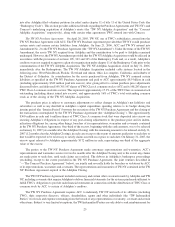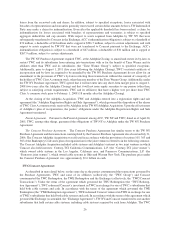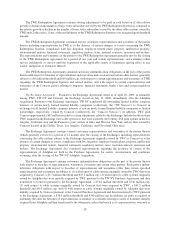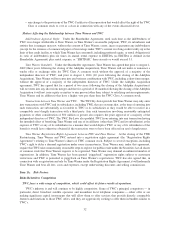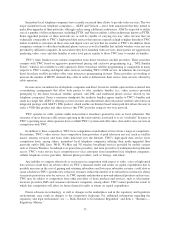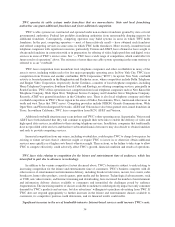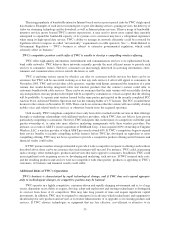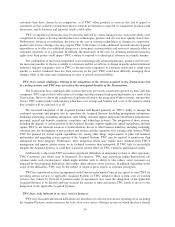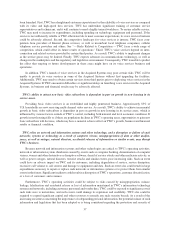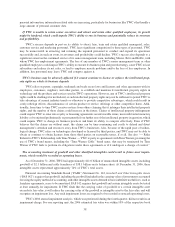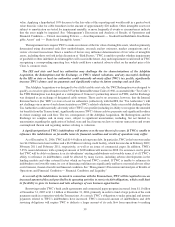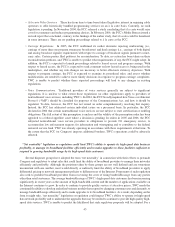Time Warner Cable 2006 Annual Report Download - page 40
Download and view the complete annual report
Please find page 40 of the 2006 Time Warner Cable annual report below. You can navigate through the pages in the report by either clicking on the pages listed below, or by using the keyword search tool below to find specific information within the annual report.The rising popularity of bandwidth-intensive Internet-based services poses special risks for TWC’s high-speed
data business. Examples of such services include peer-to-peer file sharing services, gaming services, the delivery of
video via streaming technology and by download, as well as Internet phone services. If heavy usage of bandwidth-
intensive services grows beyond TWC’s current expectations, it may need to invest more capital than currently
anticipated to expand the bandwidth capacity of its systems or its customers may have a suboptimal experience
when using its high-speed data service. TWC’s ability to manage its network efficiently could be restricted by
legislative efforts to impose so-called “net neutrality” requirements on cable operators. See “— Risks Related to
Government Regulation — TWC’s business is subject to extensive governmental regulation, which could
adversely affect its business.”
TWC’s competitive position could suffer if TWC is unable to develop a compelling wireless offering.
TWC offers high-quality information, entertainment and communication services over sophisticated broad-
band cable networks. TWC believes these networks currently provide the most efficient means to provide such
services to consumers’ homes. However, consumers are increasingly interested in accessing information, enter-
tainment and communication services outside the home as well.
TWC is exploring various means by which it can offer its customers mobile services but there can be no
assurance that TWC will be successful in doing so or that any such services it offers will appeal to consumers. In
November 2005, TWC and several other cable operators, together with Sprint, announced the formation of a joint
venture that would develop integrated cable and wireless products that the venture’s owners could offer to
customers bundled with cable services. There can be no assurance that the joint venture will successfully develop
any such products, that any products developed will be accepted by consumers or, even if accepted, that the offering
will be profitable. A separate joint venture formed by the same parties participated in the recently completed FCC
Auction 66 for Advanced Wireless Spectrum and was the winning bidder of 137 licenses. The FCC awarded these
licenses to the venture on November 29, 2006. There can be no assurance that the venture will successfully develop
mobile voice and related wireless services or otherwise benefit from the acquired spectrum.
Until recently, TWC’s telephone competitors have only been able to include mobile services in their offerings
through co-marketing relationships with affiliated wireless providers, which TWC does not believe have proven
particularly compelling to consumers. However, TWC anticipates that, in the future, its competitors will either gain
greater ownership of, or enter into more effective marketing arrangements with, these wireless providers. For
instance, as a result of AT&T’s recent acquisition of BellSouth Corp., it has acquired 100% ownership of Cingular
Wireless, LLC, a wireless provider of which AT&T previously owned 60%. If TWC’s competitors begin to expand
their service bundles to include compelling mobile features before TWC has developed an equivalent or more
compelling offering, TWC may not be in a position to provide a competitive product offering and its business and
financial results could suffer.
If TWC pursues wireless strategies intended to provide it with a competitive response to offerings such as those
described above, there can be no assurance that such strategies will succeed. For instance, TWC could, in pursuing
such a strategy, select technologies, products and services that fail to appeal to consumers. In addition, TWC could
incur significant costs in gaining access to, developing and marketing, such services. If TWC incurred such costs,
and the resulting products and services were not competitive with other parties’ products or appealing to TWC’s
customers, its business and financial results could suffer.
Additional Risks of TWC’s Operations
TWC’s business is characterized by rapid technological change, and if TWC does not respond appropri-
ately to technological changes, its competitive position may be harmed.
TWC operates in a highly competitive, consumer-driven and rapidly changing environment and is, to a large
extent, dependent on its ability to acquire, develop, adopt and exploit new and existing technologies to distinguish
its services from those of its competitors. This may take long periods of time and require significant capital
investments. In addition, TWC may be required to anticipate far in advance which technologies and equipment it
should adopt for new products and services or for future enhancements of or upgrades to its existing products and
services. If TWC chooses technologies or equipment that are less effective, cost-efficient or attractive to its
35


